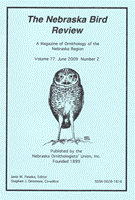Nebraska Ornithologists' Union

Nebraska Bird Review
Date of this Version
12-2023
Document Type
Article
Citation
Nebraska Bird Review, volume 91, number 4, December 2023, pp. 157–161.
Abstract
The 2023 NOU Fall Field Days were held in Holdrege on September 22–24, with approximately 45 in attendance. The programs were held at the Rodeway Inn. The meeting was planned by Robin Harding, Jan Johnson, and Ruthie Stearns. Field trips were led by Robin Harding, Paul Dunbar, and William Flack to numerous locations including Johnson Lake SRA, Elwood Reservoir WMA, the eagle viewing site on the Phelps County Canal in northern Gosper Co., the Platte River bridge south of Overton, Cottonwood WPA, Harlan Co. Reservoir, the Alma water treatment plant, Funk WPA, Nature's Mosaic Recreation Area, and Sacramento-Wilcox WPA.
The total species count was 132, including two birds which got a lot of attention: a Parasitic Jaeger at Harlan Co. Reservoir and a Clark's Nutcracker at Johnson Lake. Other species of interest were Sabine's Gull, Lesser Black-backed Gull, Common Tern, LeConte's Sparrow, and Bay-breasted Warbler.
Our Friday evening speaker was Laurel Badura, wildlife biologist with the U.S. Fish and Wildlife Service's Partners for Fish and Wildlife Program. The program covers the entire state and aims to work with landowners to preserve and restore wildlife habitat. Such restorations along the Platte River include widening the river channel and flood plain and restoring backwaters. In the Sandhills, tree and ditch removal are crucial to the effort to ensure long-term wetland habitat for migratory birds and resident wildlife. The focus is on at-risk species, but all species benefit from the changes.
Our speaker on Saturday evening was Robert Bogardus, science instructor at Mid-Plains Community College in McCook, whose topic was Aggression and Nesting Success in Tree Swallows. Bogardus observed that some swallows are more aggressive than others and wondered if aggressive males tend to select aggressive females and vice versa. In a group of 110 nest boxes, he measured aggressiveness by placing a taxidermied Tree Swallow on top of an occupied nest box and recording the number of times in a specified period attacks by the resident swallows took place. He determined that aggressive birds do indeed seek out mates with similar personalities. He also counted number of chicks fledged and average weight of chicks from aggressive pairs. He determined that aggressive pairs fledge both more chicks and larger chicks than their more passive counterparts. He mentioned that Tree Swallows are not monogamous, and it would take DNA analysis to determine if aggressiveness is heritable.
Included in
Ornithology Commons, Population Biology Commons, Poultry or Avian Science Commons, Zoology Commons


Comments
Published by the Nebraska Ornithologists’ Union, Inc.